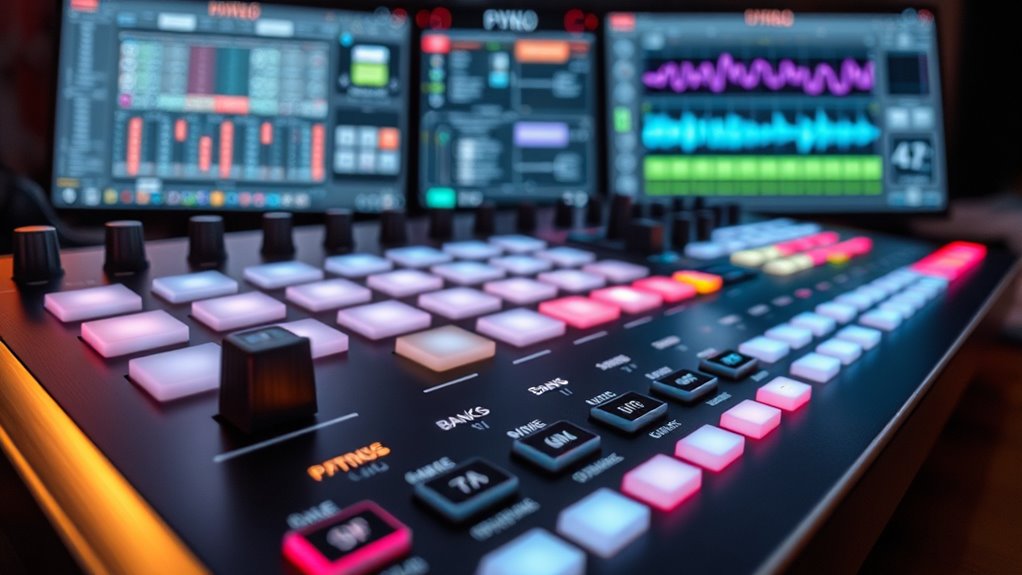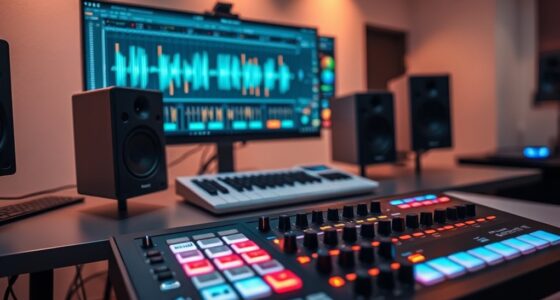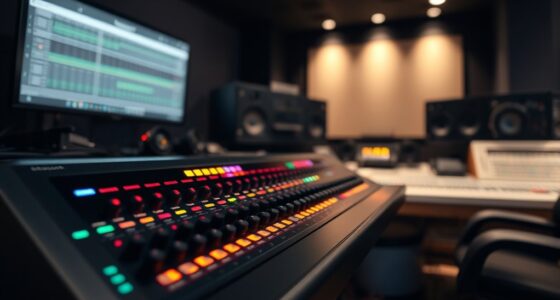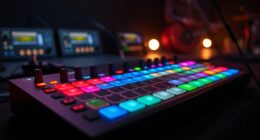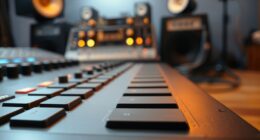When you use MIDI controllers, maps assign specific functions to knobs, faders, and buttons, while banks let you switch between groups of controls to expand your setup. Modes allow you to change control functions depending on your workflow, like mixing or editing. This setup makes your workflow flexible and efficient, so you can focus on creativity without juggling hardware. Keep exploring to discover how these elements work together to optimize your music production.
Key Takeaways
- Parameter maps assign specific functions to controls, customizing MIDI controllers for efficient workflow.
- Banks organize controls into groups, enabling access to multiple parameters without clutter.
- Modes allow controls to switch functions based on context, increasing versatility during production.
- Proper control surface design ensures ergonomic placement, enhancing accessibility and quick adjustments.
- Understanding how maps, banks, and modes interact optimizes control over complex DAW and virtual instrument tasks.
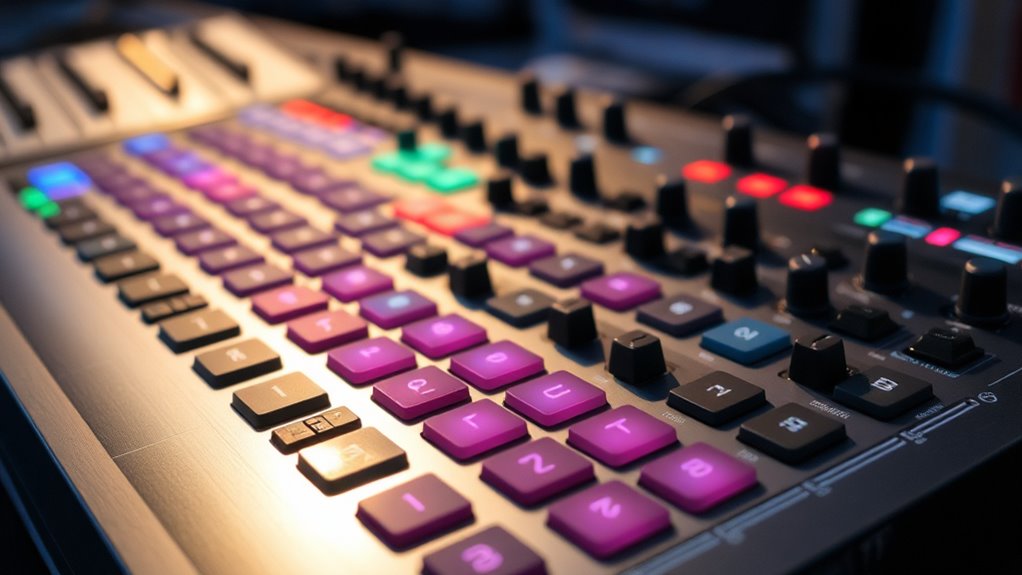
MIDI controllers are vital tools for musicians and producers, allowing you to shape and control digital music with ease. They serve as the bridge between your creative ideas and your software, giving you tactile control over various parameters. When you explore the capabilities of a MIDI controller, understanding parameter mapping becomes indispensable. This process involves assigning specific controls—knobs, faders, buttons—to different functions within your digital audio workstation (DAW) or virtual instruments. By customizing your parameter mapping, you can streamline your workflow, making it faster and more intuitive to tweak sounds, adjust effects, or trigger samples. Effective parameter mapping transforms your controller from a generic device into a personalized instrument, tailored to your production style.
Control surface design plays a significant role in how you interact with your MIDI controller. Good design ensures that controls are logically arranged, easily accessible, and comfortable to use during long sessions. Whether your controller features a compact layout or a more expansive arrangement, the design influences your ability to perform precise adjustments quickly. Many modern MIDI controllers incorporate ergonomic considerations, such as textured knobs for grip or backlit buttons for visibility in low-light environments. When selecting or customizing a control surface, think about how the layout complements your workflow. This includes the placement of controls for different modes or banks, which are vital for managing complex projects that require multiple parameter adjustments.
Banks and modes are additional layers that expand your controller’s versatility. Banks allow you to switch between groups of controls, effectively multiplying the number of parameters you can manipulate without cluttering your interface. For example, one bank might control volume levels, while another manages effects parameters. Modes, on the other hand, can change the function of controls depending on the context, such as switching from mixing to editing modes. Mastering these features enables you to perform more complex tasks efficiently, as you can access a broader range of functions without changing devices or losing focus. These features are embedded within the control surface design, making it fundamental to understand how to navigate and assign them effectively.
Frequently Asked Questions
How Do I Choose the Right MIDI Controller for My Setup?
To choose the right MIDI controller, consider your workflow and what automation features you need. Look for controllers with customization options that let you tailor controls to your setup. Think about the number of knobs, pads, or faders you require and whether they can integrate seamlessly with your software. Test different models to find one that feels intuitive and enhances your music production, making your creative process smoother.
Can MIDI Controllers Be Used With Software Instruments Only?
Did you know over 80% of producers use MIDI controllers with software instruments? Yes, you can absolutely use MIDI controllers with software instruments only. They excel in hardware integration, providing tactile control, and offer great software flexibility. With the right setup, your MIDI controller becomes a powerful tool for composing and performing, even without hardware synths. So, go ahead and explore software-based music creation—your controller’s functionality isn’t limited to hardware.
What Are the Differences Between Hardware and Software MIDI Controllers?
Hardware MIDI controllers physically connect to your setup, offering tactile control and seamless hardware integration. Software MIDI controllers, on the other hand, are virtual and customizable within your DAW, letting you tailor your control surface to your needs. You can easily adjust parameters and create personalized setups with software, while hardware controllers provide immediate tactile feedback. Both serve different preferences, so choose based on whether you prioritize physical control or software customization.
How Do MIDI Mappings Affect Live Performance Dynamics?
MIDI mappings directly influence your live performance dynamics by enabling expression mapping and performance customization. When you assign controls to specific parameters, you can quickly manipulate effects, volume, or filters, making your performance more expressive and responsive. This setup allows you to adapt instantly to the mood or energy of the crowd, giving you greater creative control and a seamless, dynamic show that feels natural and engaging.
Are There Compatibility Issues Between Different MIDI Controller Brands?
It’s like trying to fit a floppy disk into a USB port—compatibility issues do happen. You might face brand interoperability problems or firmware incompatibility between different MIDI controllers. To avoid this, check if your devices support standard protocols like MIDI over USB and verify that their firmware is up-to-date. This way, you can seamlessly integrate gear from various brands without losing your creative flow.
Conclusion
Now that you understand how maps, banks, and modes shape your MIDI controller experience, you can customize your setup, optimize your workflow, and access new creative possibilities. By mastering these elements, you gain control over your sound, your performance, and your production. Embrace the power of organization, the flexibility of adaptation, and the potential for innovation. With these tools at your fingertips, you’re ready to push boundaries, explore horizons, and make your music truly your own.

